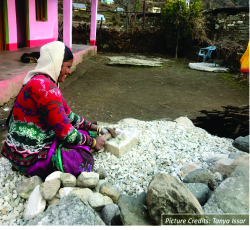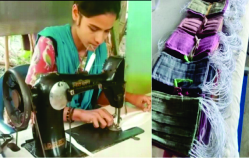|
Micro, Small and Medium Enterprises – An Engine to Build Back India Better and Faster
Micro, Small and Medium Enterprises (MSMEs) have been addressed as the bedrock of the Indian economy. They give the much-needed space to entrepreneurs to innovate and mature with the necessary support from the state in fostering a dynamic ecosystem (TOI, 23 September 2020)1. MSMEs contribute around 6.11% of the manufacturing GDP and 24.63% of the GDP from service activities. They have been able to provide employment to around 120 million people and contribute around 45% to the overall exports of India (CII, 2020). More than 90% of the MSMEs are in the unorganised sector. As the economic activities came to a halt due to the prolonged COVID lockdown, MSMEs have been faced with a great deal of uncertainty. Even before this pandemic struck, certain structural problems existed for MSMEs. Up to 85% of MSME financing in India, even today, is largely through the informal and non-banking sector. Therefore, if MSMEs are reached out by credit through markets, only 15% will be able to avail it through the formal sector (ADBI, 2019)2. This means that only those who are relatively well off can avail government support to rebuild their business. The Government of India announced an Economic Recovery Package. The focus of the package was said to be “self-reliance - to empower local economies through local enterprises, particularly MSMEs and agriculture” (The Economic Time, 13 May 2020)3. The first tranche of the package was focused on easing the pressure off MSMEs.
Fundamentally, economic recovery requires
market and product demand to pick up. Business including MSMEs need
working capital or cash to avail land, labour, energy, materials to
produce. Recovery finance can best be the ignition to re-start the
economy. The economic recovery package was found to be a little less
strategic to create markets and to replicate at scale. Infusion of cash
is expected to evaporate in a few months resulting in limited recovery. For the revival of these stressed MSMEs, the government would need to step in to share resources with them and continue to provide a credit guarantee to lenders. Given the small size of large number of MSMEs, there is a need for cluster-based approach where hand holding them with government investment in research and design innovations could lead to several benefits. As these small enterprises build back, it would seem right to green their activities in order to build back better.This can be done with low cost technologies to reduce their carbon footprint so they become Local Green Enterprises, killing the twin evils of unemployment and environmental degradation. Investing in labour intensive sectors like eco friendly clothing, sustainable housing, WASH, renewable energy, waste management would be a decent starting place.4 Case Studies from the Grassroots Bihar’s Leading Woman Green Business Entrepreneur “It is rare to find women entrepreneurs in Bihar. When I started in 2018, I was questioned by many about my abilities to run an enterprise. Today, I own one of the largest fly ash brick manufacturing units in Bihar and employ 15 other people in my unit.” - Mikki Devi, Araria district, Bihar. Mikki Devi was exploring entrepreneurship opportunities in 2017 and she connected with officials working at National Thermal Power Corporation Limited (NTPC), Kahalgaon to understand the feasibility of setting up a fly ash brick manufacturing unit – an innovative enterprise model to combat climate change by substituting red clay bricks. An ex-Mukhiya (Village Sarpanch) Mikki turned out to be a quick learner and attended classes at NTPC and online learning platforms to understand the manufacturing process, procurement and operations. Once confident about starting up, she connected with the Prime Minister’s Employment Generation Programme (PMEGP) to access subsidy and inaugurated her enterprise ‘Bhawani Shankar Fly Ash Bricks’ in April 2018. She also attended community meetings on entrepreneurship to learn about the correct sizes of brick moulds, quality control of fly ash brick manufacturing and striking partnerships with local construction projects. Today, all processes, material and finished goods at Mikki’s unit are approved by the Bureau of Indian Standards (BIS). She sells 70% of her bricks to private households and the remaining to support local government projects. Employing over 15 people, including migrant labourers, Mikki earns over INR 5,25,000 every month and has become a role model who demonstrates the potential of unleashing entrepreneurial energies to leverage new economic opportunities.
Hope and Resilience in Time of COVID
Pandemic
Heggodu village in Karnataka is home to 380 households. It is located in Sagara Block, famous for the Jog Waterfalls. It is also the base for the Charaka Natural Dye Cluster of DESI Trust and Indian Micro Enterprises Development Foundation (IMEDF). IMEDF is a special purpose vehicle of the Development Alternatives (DA) Group that accelerates the development of micro-enterprises at scale and is also the Nodal Agency (NA) for the SFURTI programme of Ministry of Micro, Small and Medium Enterprises (MSME). This cluster deals with producing designer men, women and kids wear from natural dyes. The waste coming out of the process is also used for making Quilt Covers and sold through retail outlets across India.
Anita and her younger sister have been
working with the cluster since it started in 2018. Their younger brother
is a daily wage labourer and their mother helps with casual work in the
fields around the village. With the lockdown, their work had stopped.
While Anita and her sister were receiving the salary for the last two
months, it wasn’t enough for a family of five. On 17 April 2020, around
noon, Anita’s supervisor, Padmashri visited her. She told her about a
bulk order for making masks that the Cluster received. She asked Anita
join in and if she can make around 50-60 masks every day from home?
Anita did not think twice and said yes. And since then she has been
making masks day in and day out to help her community deal with the
pandemic and also has been able to make an additional income of INR 5000
for her family. The slow hum of Anita’s sewing machine is a reminder of
near normalcy in village Heggodu. ■
Stella George
|

